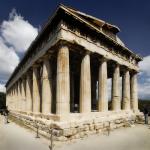|
This section contains 5,444 words (approx. 19 pages at 300 words per page) |

|
Overview of Sources.
The study of ancient Greek and Roman music depends on a wide variety of sources: iconographic, literary, and archaeological. Musical scenes, depicted in vase-paintings and frescos, in sculptural decoration and figurines, and on coins and gems, provide one piece of the puzzle. An iconographic image may show the placement of a musician's hands or mouth on an instrument, and the number of strings on a lyre, or holes in a pipe; the relative size of an instrument and the material used to construct it may, in some cases, be reasonably determined by examining an image; a guess—but no more than that—can then be made regarding pitch, tone, and volume. Images may show which instruments are played in ensemble, by whom, and on what occasion. Ancient poets, historians, lexicographers, philosophers, and theorists—most of them Greek—add much more to modern understanding...
|
This section contains 5,444 words (approx. 19 pages at 300 words per page) |

|




